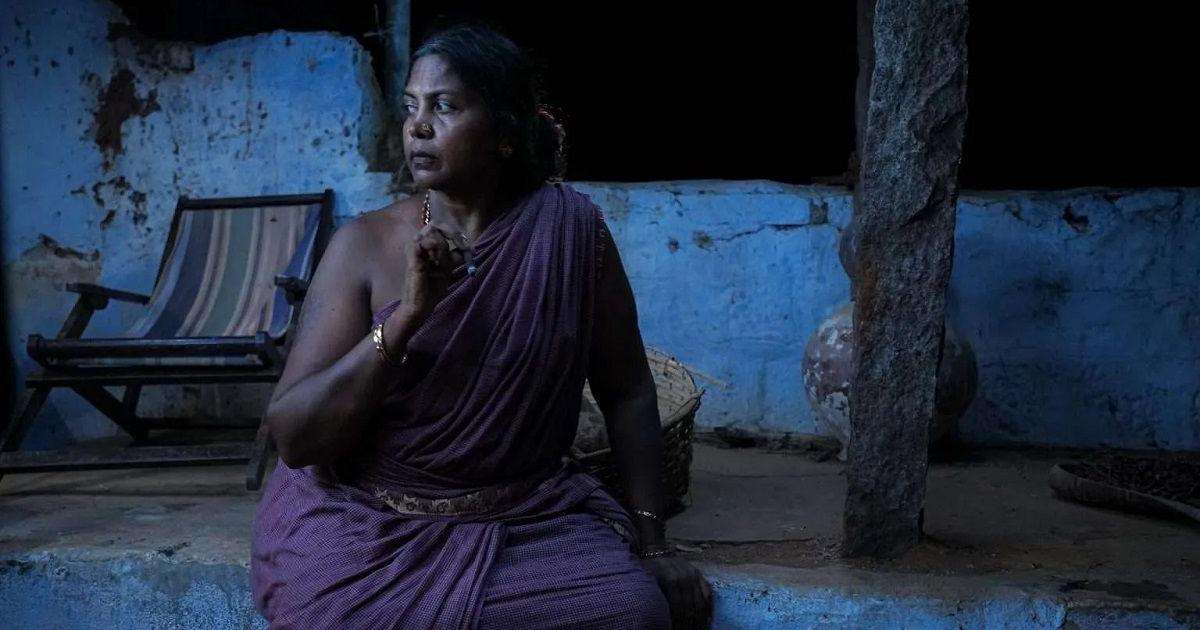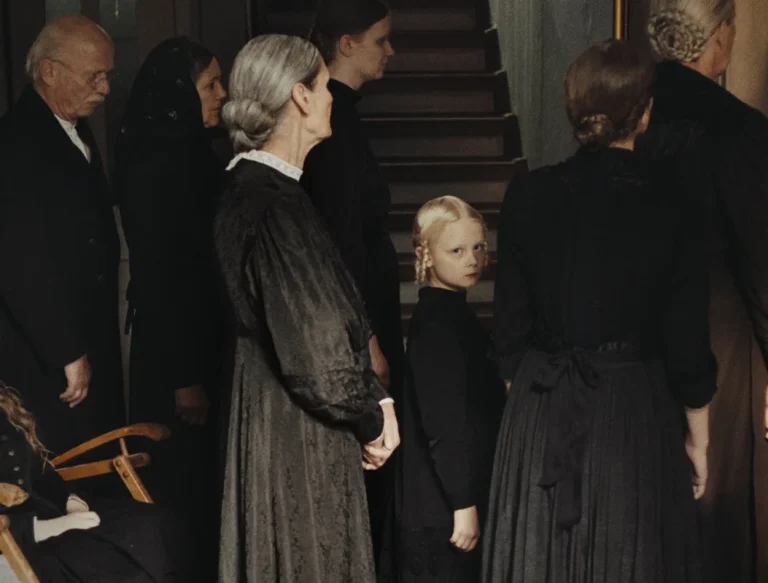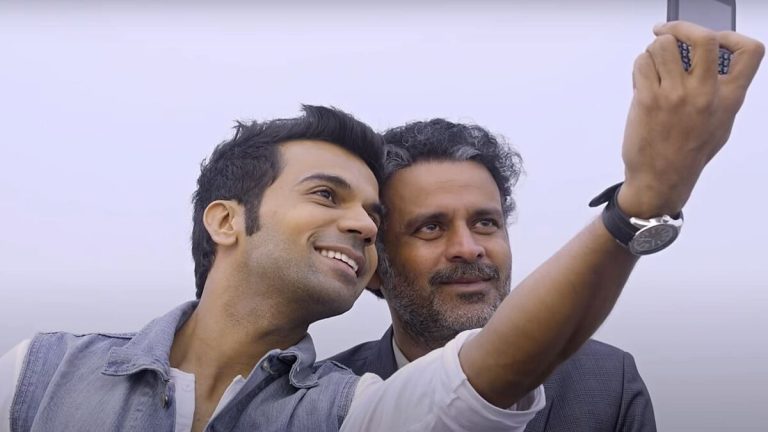It is our popular fault not allowing women faults- a fault reflected in our popular cinema. Replete with motherly, dainty, saintly, and pitiful figures, Indian cinema rarely allows women a space where they can have flaws. A self-imposed sati-syndrome that Angammal fortunately doesn’t suffer from. Based on Perumal Murugan’s short story Kodithuni the sophomore directorial of Vipin Radhakrishnan tells the story of Angammal, a beedi-smoking, foul-mouthed, Luna-driving, tattooed matriarch who refuses to wear sarees with a blouse.
The opening long shot of the wind flirting with the grass, followed by Angammal (Geetha Kailasam) entering the frame on her bike is reminiscent of simplistic yet powerful shots one has seen in early parallel films. The film begins with Angammal narrating a story of the Uchchimala Winds and its mythical symbolism to her granddaughter, with whom she behaves just like a kid, unlike the rest of her relationships.
Drawing us in with an animated, enlivened color palette that can be best described as yummy, the first few minutes establish a close friendship between Angammal and her granddaughter Manju (Yasmine), a tiff between Angammal and her daughter-in-law, Sharada (Thendral Raghunathan), her distant relationship with her eldest son, Sudalai (Bharani), her starry-eyed love for her youngest, Pavalam (Saran Shakthi) and her hidden yet overt flirtations with Kaalimuthu (Vinod). The rest of the world, she doesn’t care for.
The film’s central conflict is simple: Pavalam wants his mother to wear a blouse. He is to be married and wants to tame the mother into being presentable for his rich, urban, Christian in-laws to be; her indecent ways embarrass him, her non-feminine habits are disagreeable, her beedi-ruined teeth are disgusting, her refusal to wear a blouse is unacceptable and must be corrected. As the main conflict plays out, the minor cracks in their family life slowly reveal themselves.
At first, Pavalam successfully tricks his mother into wearing a blouse, making everyone believe that Angammal has changed for the better – they go as far as calling her a film star, a goddess. But it’s apparent how this minor change in clothing snubs her entire spark, suffocating her very spirit. Especially when she realizes that what she thought was a temporary acquiescence would be lifetime compliance.
Angammal means ‘that which is simple, graceful, and beautiful’ but our Angammal’s beauty lies outside the conditional bounds of grace. And the world simply cannot accept it. How hypocritical that a society lets men walk around shirtless, but the entire village somehow wants to convince Angammal to cover herself up? How ironic that a move towards modernity is constantly cited as a reason for Angammal to cover herself up? And how surprising that this progressive act somehow feels orthodox?

Perhaps because a blouse was never a part of the traditional saree ensemble in the Indian subcontinent. It was Western notions that deemed body exposure and any possible nudity inappropriate – this adopted into our culture became another means to control and curb a woman’s bodily autonomy and identity. But Angammal fights it, alongside her quiet best friend who are the only two blouse-less women left in the village.
It is a problem that Pavalam is unnerved by his mother and that most other men are intimidated by her. So they must do their best to not be. The pretense of male sanctimony is laid bare when Angammal’s sons silently watch as she verbally abuses Sharada, neither do they rush to find the truth when they learn that Angammal may have hit her, but they have a problem when it comes to her clothing and appearance. All this is to say that men have the liberty to choose what they have a problem with. In this case, as Pavalam’s fiancée, Jasmine eloquently puts it: “This is not even a problem.”
In an attempt to expand the world, and mythologize it while also grounding it in reality, Angammal takes creative strides away from Murugan’s short story and does this liberty justice. Radhakrishnan hints at Angammal being Asuran-esque, telling us that the Angammal we’ve met is already a tame version of herself. And if forced to wear a blouse, she will suffocate, she will lose everything that makes her, her. The film’s quest is to answer whether she will give in or not. The open ending is a cherry on top, one that makes complete sense to me, for it was the only solution that could be afforded in a situation such as this.
Angammal is an honest attempt to map rural life in Tamil Nadu, fringe stories that don’t make it to the mainstream. I can’t recall when I last watched an Indian film that so openly talked about breastfeeding, even if it was to find a way out of it. It also visibly shows us that all genders are corruptible to power; power that emanates confidence, power that allows autonomy, power that excuses assholery, and power whose need spares no one. The matriarchal figure rarely finds power and space in popular cinema to display all its hues, on the rare occasions when the opportunity presents itself.
It would be easy to call Angammal a ‘female-centric’ story but I’m wary of the term now. It is a story of a woman, like many we know, who simply doesn’t want to be told what to do. She can’t have her identity curbed, she can’t look at herself in the mirror and admire a demure version of herself. Maybe one day will come when these stories don’t feel like they’re talking from the margins, where the world would call our stories ‘stories’ and others ‘male-centric’. All this is to say that an honest attempt has been made to understand and portray female life which, hopefully, will continue.


![Bad Education [2020] Review – A true crime drama uplifted by a fantastic Hugh Jackman performance](https://79468c92.delivery.rocketcdn.me/wp-content/uploads/2020/05/Bad-Education3-highonfilms-768x320.jpg)



![Offbeat Cops [2022]: ‘NYAFF’ Review: A beautiful unconventional film with intertwined threads](https://79468c92.delivery.rocketcdn.me/wp-content/uploads/2022/07/OFFBEAT-COPS-MOVIE-REVIEW-1-768x512.jpg)
